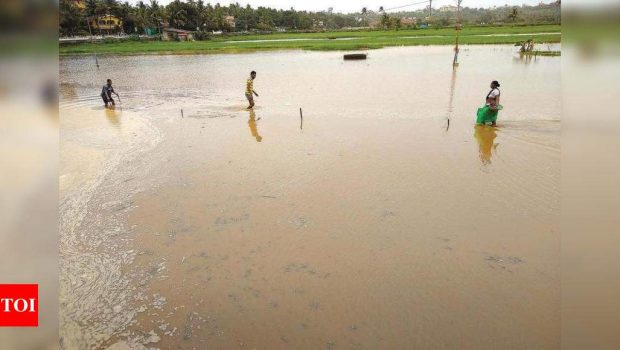State’s farmers turn to technology, research to weather nature’s vagaries | Goa News
Panaji: Cyclone Tauktae left Goa's agricultural sector devastated — leaving horticulture crops uprooted and causing fruit drop — in addition to a trail of destruction. The agriculture department pegged losses across the state at Rs 30 crore.
Farmers who had opted for late sowing of paddy were affected the most as water-logging due to rain coupled with high velocity winds flattened the crops in many areas.
Vegetable crops like ladyfinger, brinjal and sweet potato suffered damage due to water-logging in fields while mango, banana and coconut plantations were damaged by Tauktae’s cyclonic winds.
In its aftermath, scientists and agriculture experts have tried to hand-hold farmers onto the road to recovery.
From choosing crop varieties that are more resilient to climate change to applying technologies of mechanised means such as transplanters and harvesters, the changing weather parameters call for a paradigm shift in the traditional practices of farming.
“Mitigation adaptation measures are a must for the farmers so that they are better prepared to deal with the forces of nature,” ICAR-Central Coastal Agricultural Research Institute director Parveen Kumar said.
A vital form of resilient technology which has been offered to the farmers is the three-hourly Agromet Advisory Services (AAS) to keep them informed of weather variations. This bulletin is one of the largest agrometeorological information programmes in the world which collects and organises climate, weather, soil and crop information and amalgamates them with weather forecasts to assist farmers in taking appropriate measures to avoid crop loss.
In their respective farms and orchards, farmers have engaged in gap-filling by replanting new crops in place of the ones uprooted by Tauktae, last year. While it is likely to take three to five years for these crops to grow into trees, farmers are ensuring that the land that was damaged becomes fruitful again under the guidance of the agriculture department’s technical officers, ICAR-CCARI scientists and Agriculture Technology Management Agency experts.
Some farmers are of the belief that going back to the roots and picking a leaf out of history could potentially protect them from nature’s ambush.
“Earlier, we used to grow salt tolerant rice variants like Korgut and Xitto that were resistant to rainwater flooding in the fields. Since their yield is less and variants like Jaya and Jyoti give more yield, farmers decided to grow these instead. Our ancestors knew what works for the Goan soil, so it’s about time we learned something from them and switched the variants,” Chinchinim-based community farmer Agnelo Furtado said.
Some others however have a more cautious outlook towards the future of agriculture in the state.
“I have given up on my crops after facing multiple losses over the years, not just cyclone Tauktae. Many of us are still awaiting compensation from the government for our crop losses. The only safety net now is to get crop insurance to ensure that we do not face major financial losses considering how unpredictable the weather is,” a Sattari-based farmer said.
“It would also be advisable to engage in grafting, vermicompost or other aspects of agriculture that are not directly affected by the weather,” he added.








Gloss